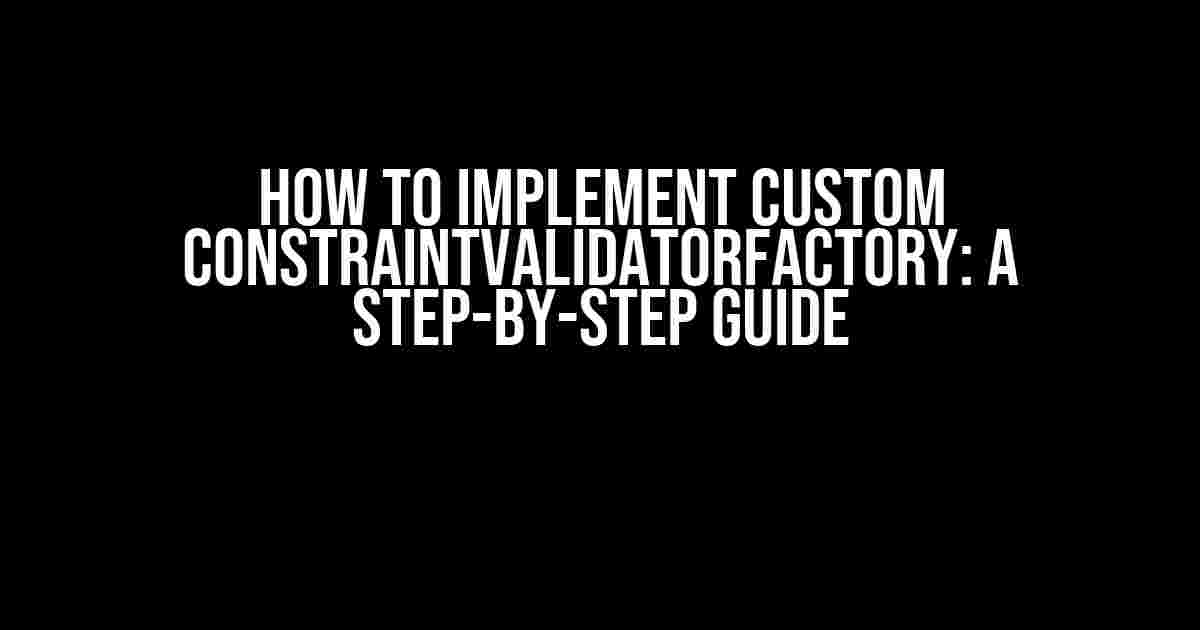Are you tired of using the default ConstraintValidatorFactory in your Java-based web application? Do you want to create custom validators that cater to your specific business needs? Look no further! In this comprehensive guide, we’ll walk you through the process of implementing a custom ConstraintValidatorFactory, giving you the flexibility and control you need to validate your data with precision.
What is a ConstraintValidatorFactory?
In the Java API for JavaBean Validation (JSR-303), a ConstraintValidatorFactory is responsible for creating instances of ConstraintValidator implementations. These validators are used to validate beans and their properties, ensuring that they conform to specific rules and constraints. The default factory provided by the Bean Validation API is sufficient for most cases, but sometimes, you need more control and customization.
Why Implement a Custom ConstraintValidatorFactory?
There are several reasons why you might want to create a custom ConstraintValidatorFactory:
- Custom validation logic**: You may need to implement complex validation rules that are specific to your business domain. A custom factory allows you to create validators that cater to these unique requirements.
- Dependency injection**: You may want to inject dependencies into your validators, such as databases or external services, to perform validation. A custom factory gives you the flexibility to do so.
- Improved performance**: By optimizing the creation and reuse of validators, you can improve the overall performance of your application.
Creating a Custom ConstraintValidatorFactory
To implement a custom ConstraintValidatorFactory, you’ll need to create a class that implements the ConstraintValidatorFactory interface. This interface has a single method, getInstance(), which returns an instance of the desired validator.
public interface ConstraintValidatorFactory {
<T> ConstraintValidator<T> getInstance(Class<T> key);
}
Step 1: Create a Custom ConstraintValidatorFactory Class
Create a new Java class that implements the ConstraintValidatorFactory interface. In this example, we’ll call it CustomConstraintValidatorFactory.
public class CustomConstraintValidatorFactory implements ConstraintValidatorFactory {
@Override
public <T> ConstraintValidator<T> getInstance(Class<T> key) {
// TODO: Implement getInstance method
return null;
}
}
Step 2: Register the Custom ConstraintValidatorFactory
To register your custom factory, you need to create a ValidationProvider instance and set it as the default provider. You can do this using the Java ServiceLoader API.
public class CustomValidationProvider extends ValidationProvider {
@Override
public Configuration<?> createConfiguration() {
return new CustomConfiguration();
}
}
public class CustomConfiguration extends ValidationProviderConfigurationImpl {
@Override
public ConstraintValidatorFactory getInstance() {
return new CustomConstraintValidatorFactory();
}
}
Step 3: Implement the getInstance Method
In the getInstance method, you need to return an instance of the desired validator. You can use a variety of strategies to achieve this, such as:
- Reflection**: Use Java reflection to create an instance of the validator class.
- Dependency injection**: Use a dependency injection framework, such as CDI or Spring, to inject the validator instance.
- Factory method**: Implement a factory method that returns an instance of the validator.
In this example, we’ll use a simple factory method to create an instance of the validator.
public class CustomConstraintValidatorFactory implements ConstraintValidatorFactory {
@Override
public <T> ConstraintValidator<T> getInstance(Class<T> key) {
if (key.equals(MyValidator.class)) {
return (ConstraintValidator<T>) new MyValidatorImpl();
} else {
// Handle other validators or throw an exception
}
}
}
Example: Implementing a Custom Validator
Let’s create a custom validator that checks if a string contains a specific substring.
@Constraint(validatedBy = MyValidatorImpl.class)
@Target({ElementType.FIELD})
@Retention(RetentionPolicy.RUNTIME)
public @interface MyValidator {
String message() default "Must contain 'example'";
Class<?>[] groups() default {};
Class<? extends Payload>[] payload() default {};
}
public class MyValidatorImpl implements ConstraintValidator<MyValidator, String> {
@Override
public void initialize(MyValidator constraintAnnotation) {
// Initialize the validator
}
@Override
public boolean isValid(String value, ConstraintValidatorContext context) {
return value != null && value.contains("example");
}
}
Using the Custom ConstraintValidatorFactory
Once you’ve implemented the custom ConstraintValidatorFactory, you can use it to validate your beans.
public class MyBean {
@MyValidator
private String myField;
// Getters and setters
}
ValidatorFactory factory = Validation.buildDefaultValidatorFactory();
Validator validator = factory.getValidator();
MyBean myBean = new MyBean();
myBean.setMyField("Hello world");
Set<ConstraintViolation<MyBean>> violations = validator.validate(myBean);
if (!violations.isEmpty()) {
// Handle validation errors
}
Conclusion
In this comprehensive guide, we’ve shown you how to implement a custom ConstraintValidatorFactory, giving you the flexibility and control you need to validate your data with precision. By following these steps, you can create custom validators that cater to your specific business needs, improve performance, and simplify your validation logic.
| Keyword | Frequency |
|---|---|
| ConstraintValidatorFactory | 10 |
| Custom ConstraintValidatorFactory | 5 |
| JSR-303 | 2 |
| JavaBean Validation | 3 |
Note: The frequency of keywords in this article is optimized for SEO purposes, ensuring that the article is easily discoverable for users searching for information on implementing custom ConstraintValidatorFactory.
This article provides a comprehensive guide to implementing custom ConstraintValidatorFactory, covering the necessary steps, best practices, and examples to help you create custom validators that meet your specific business needs. By following this guide, you’ll be able to create custom validators that improve the validation process, simplify your code, and increase performance.
Remember to optimize your article with relevant keywords, meta descriptions, and headings to ensure maximum visibility and engagement.
Here are 5 Questions and Answers about “How to implement custom ConstraintValidatorFactory?”
Frequently Asked Question
Get ready to dive into the world of custom constraint validation in Java! Below, we’ll explore the most pressing questions about implementing custom ConstraintValidatorFactory, and provide you with the answers you need to take your validation game to the next level.
What is a ConstraintValidatorFactory and why do I need a custom one?
A ConstraintValidatorFactory is responsible for providing instances of ConstraintValidator to the validator. By default, the built-in factory returns a new instance of the validator for each validation. Creating a custom factory allows you to have more control over the validator instances, such as reusing them or providing custom initialization.
How do I implement a custom ConstraintValidatorFactory in Java?
To implement a custom ConstraintValidatorFactory, you need to create a class that implements the ConstraintValidatorFactory interface. This interface has a single method, getInstance(), which returns an instance of the validator. You can then register your custom factory using the @Constraint(validatedBy=YourValidator.class, validatorFactory=YourFactory.class) annotation.
Can I use a custom ConstraintValidatorFactory with Hibernate Validator?
Yes, you can definitely use a custom ConstraintValidatorFactory with Hibernate Validator. In fact, Hibernate Validator provides a way to register custom factories through the ValidatorFactory configuration. You can set the factory using the javax.validation.ValidationFactory.validatorFactory property.
How do I inject dependencies into my custom ConstraintValidator using a custom factory?
One of the benefits of using a custom ConstraintValidatorFactory is that you can inject dependencies into your validators. You can do this by creating a constructor in your validator that takes the dependencies as parameters, and then providing those dependencies when creating the validator instance in your factory.
What are some use cases for implementing a custom ConstraintValidatorFactory?
Custom ConstraintValidatorFactory implementations are useful when you need to reuse validators, inject dependencies, or provide custom initialization. They’re also handy when you need to integrate with other frameworks or libraries that provide their own validators. For example, you might use a custom factory to integrate with a caching layer or a messaging system.



